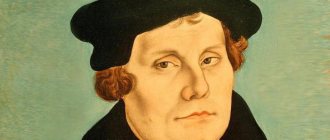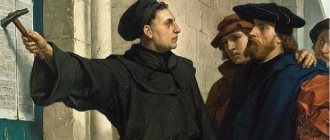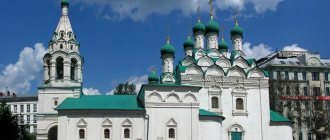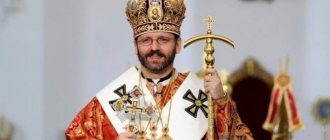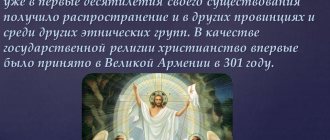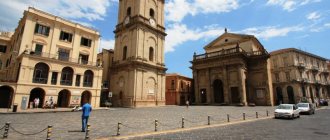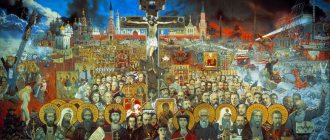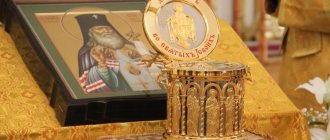From the school history course we know that Rus' was repeatedly attacked by invaders from Catholic countries under the banner of Christ. How could this happen? Don’t everyone believe in one Savior? This question became especially acute after the return of the Russian people to the Orthodox faith. My friend attends an evangelical church and actively invites me to worship services. I decided to find out the main difference between Orthodoxy and Protestantism and Catholicism by asking a priest and reliable sources about this question. In the article we will touch on the main differences between these faiths in order to get an idea of truth and fiction.
The split of the united church
To understand the differences between Orthodoxy and Catholicism and Protestantism, you need to take a mental journey into the depths of centuries. At the Seventh Ecumenical Council in 787, a split occurred in the united church, which was finally established in 1054. From that moment on, the Christian world split into two independent branches - Orthodoxy and Catholicism. The head of the Catholic Church remained the Pope, and the head of Orthodoxy was the Patriarch of Constantinople.
Find out what awaits you today - Horoscope for today for all zodiac signs
Due to numerous requests from subscribers, we have prepared an accurate horoscope application for mobile phones. Forecasts will arrive for your zodiac sign every morning - it's impossible to miss! Download for free: Daily Horoscope 2020 (available on Android)
The basis of the creed remained the resurrected Jesus Christ, and disagreements concerned only rituals and certain beliefs. All Christians (Catholics or Orthodox) believe in the trinity of the divine hypostasis, in the inheritance of the kingdom of God according to the commandments of Jesus and in his atoning sacrifice. Despite the mutual anathemas of the Catholic and Orthodox churches, the basis of faith remained the same for everyone. And the Crusades against Rus' were the result of anathemas. In 1965, both faiths were reconciled and are not at odds.
Who are Protestants and where did they come from? These were Catholics who protested against the dogmas of the Roman Catholic Church. Protestants have nothing to do with Orthodoxy. If we consider schismatics within the Orthodox Church, then our “Protestants” can be called the Old Believers who did not submit to Nikon’s reform (1650-1660).
Principles of Catholicism
How do the dogmas of the Catholic Church differ from others? The fundamental difference is the dogmas about:
- the Immaculate Conception of the Virgin Mary;
- posthumous purgatory;
- the significance of indulgences for the human soul;
- the infallibility of the Pope in his actions;
- succession of the Pope from the Apostle Paul;
- the indissolubility of the sacred bonds of marriage;
- features of the veneration of the holy martyrs.
Other differences include the doctrine of the descent of the Holy Spirit from the Father and the Son, the prohibition of marriage for an ordained priest, baptism by pouring water on the head, and the rule of imposing the sign of the cross.
A Catholic can be immediately distinguished from an Orthodox by the way he applies the sign of the cross: he touches his hand first to his left shoulder, and then to his right. Also, Catholics cross themselves not with a pinch, but with the whole palm.
Orthodoxy
After the ecumenical schism, the Orthodox branch was under the leadership of the Patriarch of Constantinople. Nowadays, there are several autocephalous (independent) Orthodox churches that resolve their issues at Councils. Orthodox churches do not honor the patriarch as their head, but Jesus Christ himself.
Orthodox priests can marry. The prohibition on marriage exists only among monks. Also on the other points listed in the section on Catholicism, the Orthodox canons differ from the Catholic ones. In particular, in the Orthodox tradition there is no dogma of the infallibility of the Pope.
An Orthodox person can be immediately distinguished from a Catholic by making the sign of a cross on himself: from right to left with three fingers (a pinch). And the Old Believers differ from the Orthodox in their double-fingered overshadowing.
Protestantism
Who are Protestants and is there a difference with Christianity? This movement arose on the European continent in the 16th century as a protest against the all-encompassing dominance of the Roman Catholic Church. There is no single center for the Protestant movement; in this movement there are many churches with different names. The first Protestant churches were:
- Anglican Church;
- Lutheran Church;
- Calvinism.
Later other trends emerged:
- Baptists;
- evangelists;
- methodologists;
- Adventists;
- Pentecostals;
- others.
Some Protestant movements are not recognized as a church and are classified as sects - Mormons, Jehovah's Witnesses. Protestants categorically deny the worship of icons, saints and monasticism, but recognize the trinity of God. Protestants firmly believe that the salvation of the soul depends on accepting Jesus Christ as a personal savior, therefore a person does not need intermediaries between him and God.
Protestants do not have prayer books, they do not light candles in churches, and at prayer services they sing songs in honor of Jesus Christ. In some Protestant churches it is customary to dance to the praises. This is especially true in neo-Protestant churches, where people clap their hands and dance in praise of Jesus. It is also not customary there to honor the Mother of God as equal to God; she is considered a simple mortal woman.
The Protestant movement is distinguished by active missionary activity, a special (fraternal) way of life and mutual assistance. The communities preach equality between all members and live as one family. The modern Anglican Church adheres to conservatism in its views, and now there is talk about its recognition of the supremacy of the Pope.
In Protestant churches, monasticism is absent as a phenomenon generally subject to consideration. Believers lead a normal lifestyle, but subject to local church regulations. Divorce is allowed, but frowned upon. The head of the community is the pastor, who is considered a role model.
Protestant denominations
Scheme of 1/3 Protestant movements and denominations belonging to them
Protestantism evolved from the Roman Catholic Church, which in turn developed from the early Christian Church. Further history gave us Lutheranism and Anglicanism.
Anglicanism also developed into such directions as: the Episcopal Church and the Evangelical Lutheran Church (also derived from Lutheranism).
Scheme 2/3 of Protestant movements and denominations belonging to them
From the development of Anglicanism already came Congregationalism, Methodism (which gave us the Salvation Army, the United Methodist Church, the Holiness movement and Pentecostalism).
Scheme 3/3 of Protestant movements and denominations belonging to them
Pure Protestantism has already given us Quakerism, Baptistism (which developed into the Southern Baptist Convention, Adventism and the Seventh-day Adventists), Anabaptism (which gave us Mennonite and Amish), and Reformedism (which developed into Presbyterianism and the Church of Scotland).
Differences between faiths
Let's look at the fundamental differences between faiths using comparative examples.
Internal organization of churches
In Orthodoxy, there are many autocephalous local churches, which differ in some nuances in rituals and canonical forms.
In Russia, all churches are subordinate to the Moscow Patriarchate.
In Catholicism, everything rests on the authority of the Pope. Monastic orders are endowed with some freedom. The infallibility of the Pope is recognized by almost all churches, with the exception of traditionalists and Old Catholics.
There is no single organizing center in the Protestant movement. Each community exists independently of the other, recognizing the authority of Jesus Christ.
Marriage and monasticism
Orthodoxy has a developed monastic movement, the distinctive feature of which is the vow of celibacy. White clergy (priests) can marry (only once).
In the Catholic Church, all clergy take a vow of celibacy, regardless of monastic vows.
Protestantism completely denies monasticism and recognizes the institution of marriage. Members of the community can marry and divorce. Divorce is acceptable, but not universally welcomed. Some churches prohibit remarriage.
Authorities
In the Orthodox faith, Jesus Christ and the Holy Gospel are revered as the highest authority. Vital issues of Orthodoxy are decided at the Ecumenical Council by a majority vote.
In Catholicism, the highest authority is considered to be the opinion of the Pope and his position on spiritual issues. The authority of holy scripture is also recognized as the basis of religion. Catholics resolve community issues at their Ecumenical Councils.
In Protestantism, the Gospel is considered the highest authority. However, there are so many ways to interpret the Gospel that believers cannot agree on a single opinion. Each community has its own view of the letters of the apostles, which is considered the only true one.
Doctrine of Saint Mary
In the Orthodox Church, the Mother of God is considered sinless, since she did not have original sin. The Orthodox also claim that after the Dormition the Mother of God was taken to heaven.
Catholics support the Orthodox faith in the purity of the Virgin Mary. There was no sin on her.
In Protestant churches, the Mother of Christ is considered an ordinary woman, a model of holiness and righteous behavior.
Dogma of posthumous purgatory
In the Orthodox Church there is a dogma about ordeals, that is, post-mortem tests of the soul.
In the Catholic Church they talk about purgatory, which every soul goes through to be cleansed from sins.
Protestant churches reject both the ordeal of the soul and purgatory.
Church Sacraments
The Orthodox and Catholic churches recognize 7 Church Sacraments:
- baptism;
- repentance;
- Eucharist;
- marriage;
- anointing;
- unction;
- priesthood.
Protestant churches recognize only two sacraments - baptism and communion (Eucharist).
Sacrament of Baptism
In the Orthodox and Catholic churches, newborn children are baptized. In the Protestant Church, baptism is accepted, as a rule, at a conscious age. Immersion in water is not compulsory in Protestant communities. If baptism is carried out with water, then in the river.
Sacrament of Communion
In Orthodox churches they receive communion with yeast bread and wine. This applies to both the clergy and the congregation.
In Catholic churches they receive communion with unleavened bread. The clergy receives communion with bread and wine, the congregation with bread only.
In Protestant churches there is no single custom of communion; everything depends on the charter of the community.
Secret of Confession
In the Orthodox Church, sins are confessed before each communion, and the priest accepts the confession. Repentance can be performed without communion.
In the Catholic faith, confession can take place without the presence of a priest, as well as with his presence - if desired.
In Protestant churches, no mediation between God and man is recognized, so one can repent of sins without witnesses.
Form of worship
In Orthodox churches, ritual services are carried out according to the Eastern (Byzantine) model. There is no musical accompaniment during the service; women and men take part in the choir.
In Catholic churches, services (mass) are conducted according to the Latin or Eastern model. Organ music is played at masses, and only boys (men) participate in the choir.
In modern Protestant churches, services are held without a ritual part, mainly sermons and glorification of God. There is choral singing and accompaniment on various musical instruments, up to a modern drum set. During worship, believers can dance and clap.
Veneration of icons
The Orthodox Church has developed the worship of icons and veneration of the cross (crucifixion). Believers turn directly to the icon with a prayer of faith.
The Catholic Church venerates the crucifix and icons. But during prayer they do not turn to the icon, but only stand in front of it.
Protestant churches recognize only the cross without the crucifix. There are no icons or sculptures; this is considered idolatry.
Veneration of saints and dead
In the Orthodox and Catholic churches, the veneration of saints is customary. It is also customary to pray for the dead.
In Protestant churches, the cult of the dead is rejected and saints are not venerated.
Doctrines[edit]
Let us consider such a phenomenon as apostolic succession. Let’s take, for example, the most ordinary Orthodox priest. When did he become a priest, that is, a person entitled to perform the sacraments? Not upon graduation from seminary, but only when he was ordained
to this by the bishop.
This bishop, in turn, was also not born with this right, but was ordained by
a third bishop even earlier, and that bishop even earlier... And our priest, if he rises to the rank of bishop, then he himself will be able to ordain young seminary graduates. So, the essence of apostolic succession is that for any priest, including the most seedy priest from the most seedy parish, this continuous chain of ordinations can, at least theoretically, be traced back centuries to Jesus Christ himself, who ordained His 12 disciples. Orthodox and Catholics strictly adhere to this rule. Since the time of Martin Luther, Protestants have not considered apostolic succession as a mandatory requirement for the priesthood (which is why the Orthodox from the first two branches refuse to recognize them as Christians). However, not all: Scandinavian Lutherans and Anglicans initially preserved it, and later it was restored from them in some other Protestant denominations.
Reconciliation of churches
The schism and subsequent hostility between Christian denominations was eliminated at the Second Vatican Council in 1965. From that moment on, the Roman Catholic Church recognized its beloved sister in Orthodoxy, and called the Protestant movements Christian associations. This was a great progress among the Christians of the world, since all faiths and movements were officially recognized as true and valid.
The centuries-old enmity ended, the anathemas were lifted, and the entire Christian world breathed a sigh of relief to the envy of its enemies. Despite the fact that Orthodoxy and Catholicism continue to consider their teachings the only correct ones, there is no open hostility between them. Today no one persecutes Protestants and Old Believers, considering them schismatics and sectarians. Love and harmony reigned in the world, as Jesus Christ commanded all his followers.
Main directions of Christianity: Orthodoxy, Catholicism, Protestantism
Christianity created the ideal of universal human behavior, their existence, a holistic worldview and attitude.
The basis of Christianity is the teaching about Jesus Christ - the God-man, the son of God, who came to people with good intentions, commanding them the laws of righteous life and accepting suffering and martyrdom crucified on the cross in atonement for human sins. Christians believe that the world was created by one eternal God, and there was no evil in this world. The resurrection of Christ marked for Christians victory over death and the possibility of eternal life with God. The main idea of Christianity was the idea of sin and human salvation. People are sinners in the face of God, this makes everyone equal, all people are sinners, all are God's servants.
Finished works on a similar topic
Course work The main directions of Christianity: Orthodoxy, Catholicism, Protestantism 480 ₽ Abstract The main directions of Christianity: Orthodoxy, Catholicism, Protestantism 230 ₽ Test work The main directions of Christianity: Orthodoxy, Catholicism, Protestantism 240 ₽
Get completed work or consultation with a specialist on your educational project Find out the cost
The Christian religion claims that suffering on Earth gives a person peace and heavenly bliss in the afterlife, and resistance to evil is the path to moral improvement.
Note 1
The main directions in Christianity are Orthodoxy, Catholicism, and Protestantism.
The reason for the split in religion is that, starting from the 4th century, Roman Christianity increasingly united with the state and absorbed its pro-pagan spirit. The Catholic Church, being based on the traditions of Rome, gravitated more towards Roman practicality and cruelty. Orthodoxy absorbed the spirit of Byzantium and gravitated towards sublime Greek philosophizing.
In other words, the two traditions had their origins in two different worlds - Greek and Roman, and therefore began to move away from each other.
